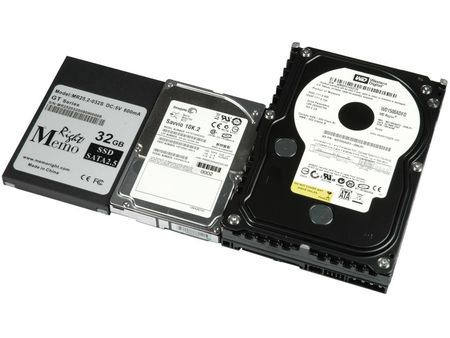Memoright SSDs: The End of Hard Drives?
The HDD is Beaten
About six months ago, we reviewed Mtron’s Flash SSDs (Solid State Drives), which were the fastest hard drives for desktop PCs until the launch of Western Digital’s new VelociRaptor. Although the VelociRaptor is a conventional hard drive and therefore it cannot offer the extremely quick access times of transistor-based storage media, it is the best choice for most applications - and it offers almost 10 times the capacity at a fraction of the SSD drive’s cost. However, we found an even better drive for the real enthusiast: the Memoright SSD MR25.2-032S, which leaves any other conventional hard drive in the dust as far as performance goes.
It has become difficult to keep track of the developments in the Flash SSD storage market. Flash SSDs look and behave like mechanical hard drives, except that flash memory devices store data in the same way that your motherboard’s firmware device stores BIOS information. USB thumb drives use flash memory as well. Flash memory can offer good throughput and virtually zero access time, although write throughput and write access times can be clearly slower than the read values. While Flash memory doesn’t generate as much heat as a hard drive spinning at high revolution speeds and it’s also extremely robust, the media does not yet offer the capacities that PC hard drives are expected to have. A 2.5” notebook hard drive, for example, can store up to 500 GB and a 3.5” desktop drive’s capacity can total up to 1000 GB.
However, flash-based drives can come in 3.5”, 2.5”, 1.8” or even smaller sizes. Remember that memory cards such as CompactFlash, SD or memory sticks are all based on flash memory. Flash memory typically requires much less power than a conventional hard drive does, and it withstands shocks, such as when a laptop is dropped, better than conventional drives. Flash SSD storage capacities have reached 128 GB, although only 32-GB flash SSDs have moved into a price range that can be considered affordable.
But why do we make such a big deal about SSDs in the first place? There are two simple reasons: performance and energy efficiency. While traditional hard drives do not directly accelerate processing performance for CPU-intensive tasks or graphics performance, they have a very noticeable impact whenever the operating system, applications or application data are launched or terminated. Once software can be executed or data can be accessed from within the system’s main memory, the core components can show their potential. Until this is the case, data has to be loaded or stored from or to the hard drive, which is why we still have to wait seconds or even minutes for Windows or applications to start. Flash SSDs can significantly reduce user idle time by providing a good mix of quicker data access and good throughput. Lastly, flash memory devices can be more energy-efficient than conventional hard drives. However, an SSD’s energy power consumption depends on the number of flash components the device has for its capacity. Flash memory’s power consumption also can vary (MLC, SLC – see next page).
We already looked at various Flash SSD offerings from Samsung, Sandisk, Ridata and the Korean manufacturer Mtron, which has been offering the fastest flash SSD drives to date. Executives from SSD specialist DV Nation read our review of the Mtron drives and offered flash SSD from Memoright for our tests. A company representative said the devices would be an even better choice. He was right.
Get Tom's Hardware's best news and in-depth reviews, straight to your inbox.
